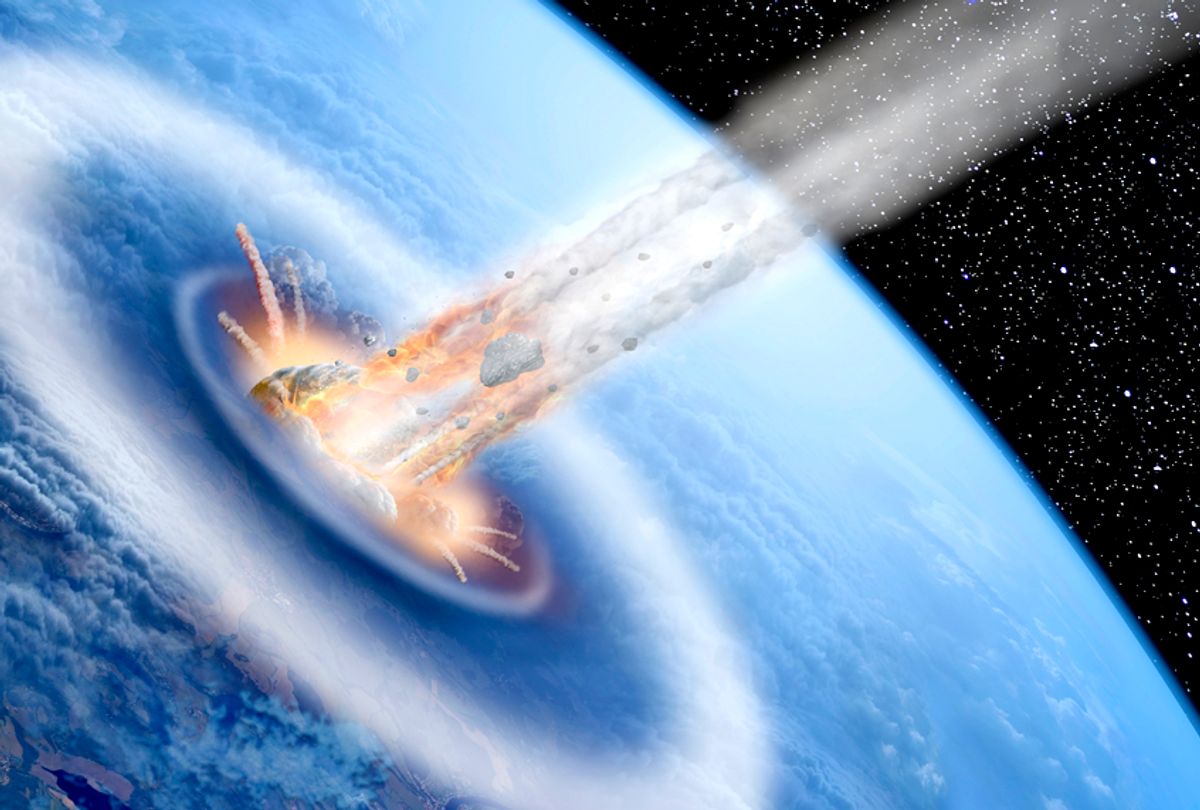There are a few things that scientists know about the dinosaur-killing asteroid that hit the Earth around 66 million years ago. Its impact site is the Chicxulub crater, which is on the Yucatán Peninsula in Mexico. The asteroid in question was roughly about six to nine miles wide and it was the beginning of the end for 75 percent of the world’s animal and plant species at the time, including dinosaurs.
A new study published in Proceedings of the National Academy of Sciences on Monday suggests that the asteroid did not only lead to a mass extinction for dinosaurs and other species on land, but it was the cause of a massive wipeout for the world’s oceans and marine life. The findings in the study, which was led by Dr. Michael Henehan of the GFZ German Research Centre for Geosciences and researchers at Yale University, is the first direct evidence that the Cretaceous-Paleogene extinction was caused in part by a decrease in the oceans' pH levels. This likely happened because the asteroid impact led to sulfur-rich rocks creating acid rain, which went into the ocean and disrupted its ecosystem.
Researchers took rock samples from the Netherlands to analyze the chemical composition of the fossilized foraminifera — small plankton that have an impressive fossil record dating back hundreds of millions of years ago — from before, during, and after the asteroid hit. They measured boron isotopes, which helped them understand the changes in the ocean’s acidity. They also reconstructed water-column pH gradients with the help of Earth system modeling, and found the proportions of the boron isotopes change when the acidity of the oceans increases. Since this shift happened in the first 100 to 1,000 years after the asteroid impact, in the grand context of time in the universe, it happened almost instantly, hence it being termed a “flash” acidification event.
Their findings reconcile competing theories of what happened to cause the ocean’s pH levels to rise. For example, some researchers have suggested that volcanic eruptions began to occur hundreds of thousands of years before the Cretaceous–Paleogene extinction, which would have positioned Earth to be more susceptible to a mass extinction. Instead, the evidence suggests the impact of the asteroid caused pH levels in the ocean to decline.
“Our data suggest that impact, not volcanism, was key in driving end-Cretaceous mass extinction,” the authors state in the study.
While acidification had been predicted by other researchers, Noah Planavsky, a biogeochemist at Yale and one of the study’s authors, told Salon in an interview it is surprising that they were able to find an isotopic signal as evidence to indicate the true magnitude of the impact's effects.
“We knew there was some acidification from this impact, but we were surprised to have found that because it likely occurred over such a short interval,” Planavsky said. “We expected to see some acidification, but we didn’t know how big it would be and we were surprised to find it.”
In other words, their findings suggest that the asteroid that created Cretaceous-Paleogene extinction was likely more disastrous than previously thought.
“We knew there was an extinction, one of the most pronounced in the history of our planet, and the impact lasted for millions of years. It was a short event that lasted millions of years,” Planavsky said.
What is alarming is that acidification is currently happening in the planet’s oceans today, even without an asteroid to disrupt the environment because of carbon dioxide emissions. According to the National Oceanic and Atmospheric Administration (NOAA), over the last 200 years — since the industrial revolution — the pH of the ocean surface has fallen by 0.1 pH units. Based on the current rate of carbon dioxide levels, evidence suggest that the ocean could be 150 percent more acidic by the end of the century, according to NOAA, “resulting in a pH that the oceans haven’t experienced for more than 20 million years.”
Planavsky said the latest evidence from the study gives us insight into what will be happening in the future if carbon emissions continue to rise.
“Depending on what we do for carbon emissions we could very easily have something more extreme than the signal we are seeing,” Planavsky told Salon. “The sort of degree of acidification we are seeing is certainly in the realm of what people are discussing for the next 100 years, and it seems not only does it have a short-term effect, but it seems to have had effects on marine ecosystems. The short-term event destabilized and altered the structure of ecosystems for millions of years, so this should be something that is yes, horrifying to us. It’s in the realm of something we could see in the future, but hopefully we don’t see something as large.”

Shares